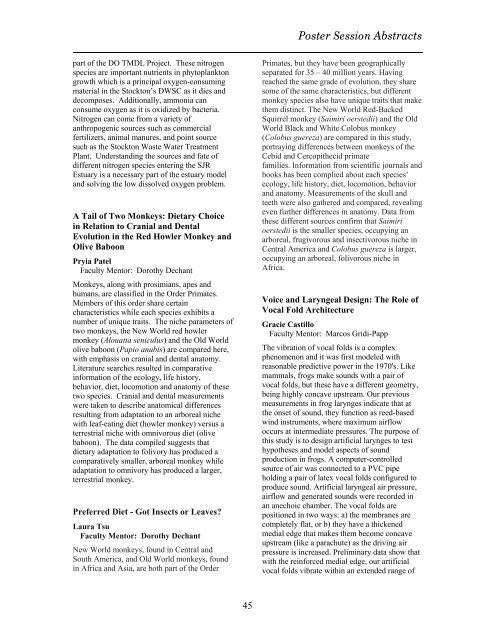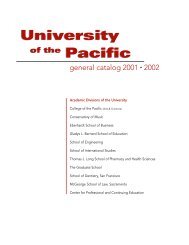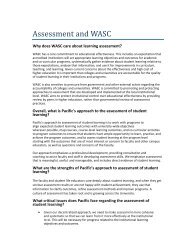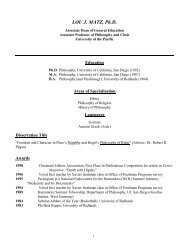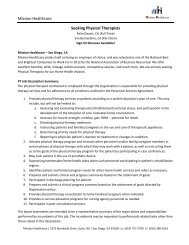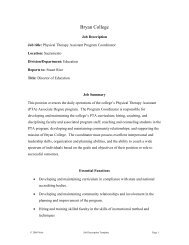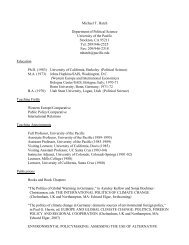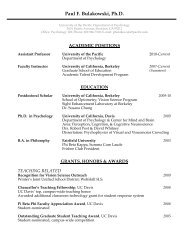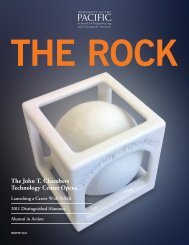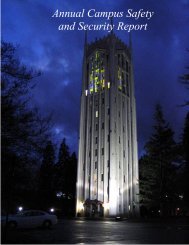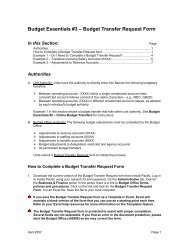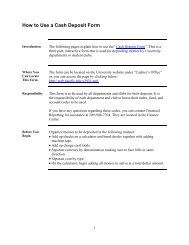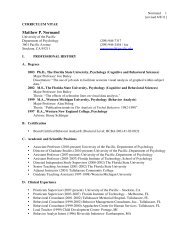purcc 2012 - University of the Pacific
purcc 2012 - University of the Pacific
purcc 2012 - University of the Pacific
You also want an ePaper? Increase the reach of your titles
YUMPU automatically turns print PDFs into web optimized ePapers that Google loves.
Poster Session Abstracts<br />
part <strong>of</strong> <strong>the</strong> DO TMDL Project. These nitrogen<br />
species are important nutrients in phytoplankton<br />
growth which is a principal oxygen-consuming<br />
material in <strong>the</strong> Stockton’s DWSC as it dies and<br />
decomposes. Additionally, ammonia can<br />
consume oxygen as it is oxidized by bacteria.<br />
Nitrogen can come from a variety <strong>of</strong><br />
anthropogenic sources such as commercial<br />
fertilizers, animal manures, and point source<br />
such as <strong>the</strong> Stockton Waste Water Treatment<br />
Plant. Understanding <strong>the</strong> sources and fate <strong>of</strong><br />
different nitrogen species entering <strong>the</strong> SJR<br />
Estuary is a necessary part <strong>of</strong> <strong>the</strong> estuary model<br />
and solving <strong>the</strong> low dissolved oxygen problem.<br />
A Tail <strong>of</strong> Two Monkeys: Dietary Choice<br />
in Relation to Cranial and Dental<br />
Evolution in <strong>the</strong> Red Howler Monkey and<br />
Olive Baboon<br />
Pryia Patel<br />
Faculty Mentor: Dorothy Dechant<br />
Monkeys, along with prosimians, apes and<br />
humans, are classified in <strong>the</strong> Order Primates.<br />
Members <strong>of</strong> this order share certain<br />
characteristics while each species exhibits a<br />
number <strong>of</strong> unique traits. The niche parameters <strong>of</strong><br />
two monkeys, <strong>the</strong> New World red howler<br />
monkey (Alouatta seniculus) and <strong>the</strong> Old World<br />
olive baboon (Papio anubis) are compared here,<br />
with emphasis on cranial and dental anatomy.<br />
Literature searches resulted in comparative<br />
information <strong>of</strong> <strong>the</strong> ecology, life history,<br />
behavior, diet, locomotion and anatomy <strong>of</strong> <strong>the</strong>se<br />
two species. Cranial and dental measurements<br />
were taken to describe anatomical differences<br />
resulting from adaptation to an arboreal niche<br />
with leaf-eating diet (howler monkey) versus a<br />
terrestrial niche with omnivorous diet (olive<br />
baboon). The data compiled suggests that<br />
dietary adaptation to folivory has produced a<br />
comparatively smaller, arboreal monkey while<br />
adaptation to omnivory has produced a larger,<br />
terrestrial monkey.<br />
Preferred Diet - Got Insects or Leaves?<br />
Laura Tsu<br />
Faculty Mentor: Dorothy Dechant<br />
New World monkeys, found in Central and<br />
South America, and Old World monkeys, found<br />
in Africa and Asia, are both part <strong>of</strong> <strong>the</strong> Order<br />
Primates, but <strong>the</strong>y have been geographically<br />
separated for 35 – 40 million years. Having<br />
reached <strong>the</strong> same grade <strong>of</strong> evolution, <strong>the</strong>y share<br />
some <strong>of</strong> <strong>the</strong> same characteristics, but different<br />
monkey species also have unique traits that make<br />
<strong>the</strong>m distinct. The New World Red-Backed<br />
Squirrel monkey (Saimiri oerstedii) and <strong>the</strong> Old<br />
World Black and White Colobus monkey<br />
(Colobus guereza) are compared in this study,<br />
portraying differences between monkeys <strong>of</strong> <strong>the</strong><br />
Cebid and Cercopi<strong>the</strong>cid primate<br />
families. Information from scientific journals and<br />
books has been complied about each species’<br />
ecology, life history, diet, locomotion, behavior<br />
and anatomy. Measurements <strong>of</strong> <strong>the</strong> skull and<br />
teeth were also ga<strong>the</strong>red and compared, revealing<br />
even fur<strong>the</strong>r differences in anatomy. Data from<br />
<strong>the</strong>se different sources confirm that Saimiri<br />
oerstedii is <strong>the</strong> smaller species, occupying an<br />
arboreal, frugivorous and insectivorous niche in<br />
Central America and Colobus guereza is larger,<br />
occupying an arboreal, folivorous niche in<br />
Africa.<br />
Voice and Laryngeal Design: The Role <strong>of</strong><br />
Vocal Fold Architecture<br />
Gracie Castillo<br />
Faculty Mentor: Marcos Gridi-Papp<br />
The vibration <strong>of</strong> vocal folds is a complex<br />
phenomenon and it was first modeled with<br />
reasonable predictive power in <strong>the</strong> 1970's. Like<br />
mammals, frogs make sounds with a pair <strong>of</strong><br />
vocal folds, but <strong>the</strong>se have a different geometry,<br />
being highly concave upstream. Our previous<br />
measurements in frog larynges indicate that at<br />
<strong>the</strong> onset <strong>of</strong> sound, <strong>the</strong>y function as reed-based<br />
wind instruments, where maximum airflow<br />
occurs at intermediate pressures. The purpose <strong>of</strong><br />
this study is to design artificial larynges to test<br />
hypo<strong>the</strong>ses and model aspects <strong>of</strong> sound<br />
production in frogs. A computer-controlled<br />
source <strong>of</strong> air was connected to a PVC pipe<br />
holding a pair <strong>of</strong> latex vocal folds configured to<br />
produce sound. Artificial laryngeal air pressure,<br />
airflow and generated sounds were recorded in<br />
an anechoic chamber. The vocal folds are<br />
positioned in two ways: a) <strong>the</strong> membranes are<br />
completely flat, or b) <strong>the</strong>y have a thickened<br />
medial edge that makes <strong>the</strong>m become concave<br />
upstream (like a parachute) as <strong>the</strong> driving air<br />
pressure is increased. Preliminary data show that<br />
with <strong>the</strong> reinforced medial edge, our artificial<br />
vocal folds vibrate within an extended range <strong>of</strong><br />
45


